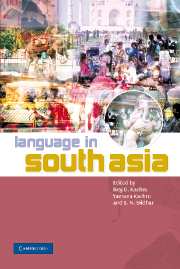Book contents
- Frontmatter
- Contents
- List of Figures
- List of Maps
- List of Tables
- Preface
- Acknowledgments
- List of Abbreviations
- Note on Transcription
- Introduction: languages, contexts, and constructs
- Part 1 Language history, families, and typology
- Part 2 Languages and their functions
- Part 3 Sanskrit and traditions of language study
- Part 4 Multilingualism, contact, and convergence
- Part 5 Orality, literacy, and writing systems
- Part 6 Language conflicts
- Part 7 Language and modernization
- Part 8 Language and discourse
- 17 Language in social and ethnic interaction
- 18 Language and the legal system
- 19 Language in the media and advertising
- 20 Language in cinema
- 21 Language of religion
- Part 9 Language and identity
- Part 10 Languages in diaspora
- References
- Subject Index
- Language Index
- Author Index
17 - Language in social and ethnic interaction
Published online by Cambridge University Press: 04 May 2010
- Frontmatter
- Contents
- List of Figures
- List of Maps
- List of Tables
- Preface
- Acknowledgments
- List of Abbreviations
- Note on Transcription
- Introduction: languages, contexts, and constructs
- Part 1 Language history, families, and typology
- Part 2 Languages and their functions
- Part 3 Sanskrit and traditions of language study
- Part 4 Multilingualism, contact, and convergence
- Part 5 Orality, literacy, and writing systems
- Part 6 Language conflicts
- Part 7 Language and modernization
- Part 8 Language and discourse
- 17 Language in social and ethnic interaction
- 18 Language and the legal system
- 19 Language in the media and advertising
- 20 Language in cinema
- 21 Language of religion
- Part 9 Language and identity
- Part 10 Languages in diaspora
- References
- Subject Index
- Language Index
- Author Index
Summary
Introduction
All social and ethnic groups operate within a cultural context, and as such, culture becomes a relevant parameter in any discussion of social and ethnic interaction. Before discussing the role of language in interaction in South Asia, it is necessary to briefly examine what is meant by culture and what aspects of culture are relevant to this discussion.
As Halliday (1993: 11) observes, the relationship between language and culture is not deterministic. Rather, “culture and language co-evolve in the same relationship as that in which, within language, meaning and expression co-evolve.” What I attempt to do in this chapter is to look at the interaction of language and culture as it manifests itself in strategies of oral and written interaction in South Asia.
The chapter is organized as follows: the first section discusses the interface of the relevant aspects of culture and language in social interaction in the South Asian context, the second section focuses on the general conventions of verbal interaction, and the third section concentrates on the traditions and constraints that operate in academic discourse in South Asia. The conclusion presents a summary of the discussion and points to areas of research that need attention.
The cultural context of language
First, “culture” is not an easy concept to define. It has been defined in many different ways in the anthropological literature.
- Type
- Chapter
- Information
- Language in South Asia , pp. 345 - 360Publisher: Cambridge University PressPrint publication year: 2008
- 5
- Cited by



